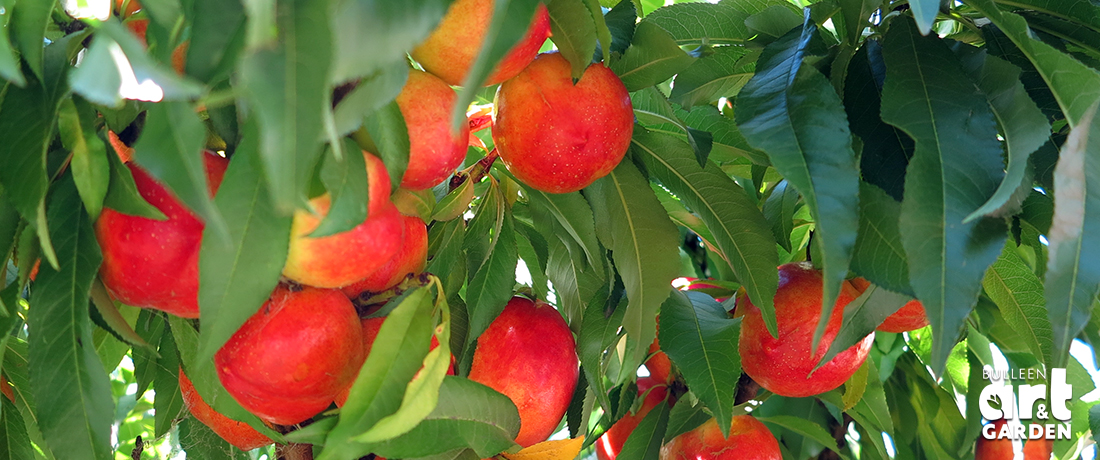
 Important note about plant availability. Important note about plant availability.There are hundreds of factsheets on our website provided for your information. Not all plants will be available at all times throughout the year. To confirm availability please call (03) 8850 3030 and ask for the nursery. |
Nothing compares to the taste of a home grown, freshly picked peach or nectarine. Bursting with flavour and heavy with juice, once you have tasted peaches from your own tree you’ll never go back to canned again. As well as being tasty, peaches and nectarines are also really good for you. Both contain high levels of Vitamins A and C, as well as potassium, magnesium and beta-carotine.
Nectarines are essentially a smooth-skinned peach… that’s why we have them together on the one factsheet.
Peaches and nectarines grow really well in Melbourne as we have the perfect mild climate and a nice cold winter. If you live in an area of Melbourne that is prone to late frosts consider protecting your peaches and nectarines with shadecloth or similar as these late/spring frosts can severely damage the flowers (and impact yield).
Find a nice sunny position in your garden and ensure the soil is full of organic matter and free draining. This can be a bit of a challenge on some of our heavy clay Melbourne soils, so incorporate some gypsum and compost prior to planting and consider planting your peaches on a mound to improve drainage.
To get good large fruit thin excess fruit after fruit set and keep the tree well watered as fruit is growing. Thinning fruit also helps avoid brown rot.
For eating, peaches and nectarines are best left on the tree until ripe as their flavour is far more intense. Fruit picked while firm is fantastic for cooking and will still ripen away from the tree.
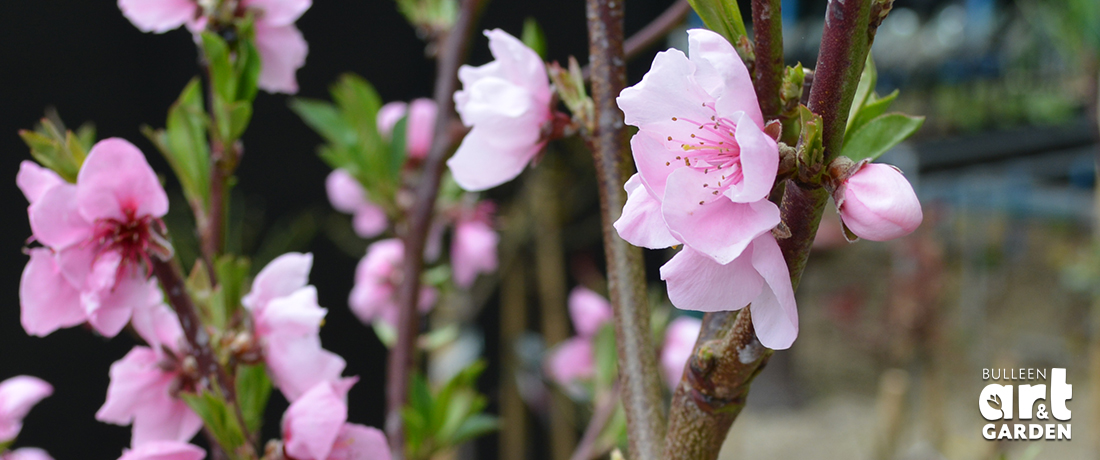
Peaches and nectarines are ideal for smaller gardens as they are generally self fertile, meaning they don’t require another tree for cross pollination. If you are really pushed for space, consider a dwarf nectarine or peach, a multi-grafted tree, or duo planting.
Peach leaf curl is endemic and all peaches and nectarines need to be sprayed with a fungicide over winter and at bud swell.
 Important note about plant availability. Important note about plant availability.There are hundreds of factsheets on our website provided for your information. Not all plants will be available at all times throughout the year. To confirm availability please call (03) 8850 3030 and ask for the nursery. |
Nectarine – Arctic Rose: Freestone, New generation of white fleshed nectarine. Picked and eaten when still quite firm they are a taste sensation. Matures throughout February. Spray at bud swell with copper to control curly leaf. Prune previous season’s growth as required. Picked firm, they are very sweet with little or no fruit acid. Bright red colour over a creamy-green background. Used mainly for fresh fruit but has potential for drying, bottling and cooking. Freestone. Self fertile
Nectarine – Crimson Baby – Dwarf: Medium to large fruit with yellow skin and a red blush. Yellow flesh clingstone widely grown. Fruits late November. Fully self pollinating and prolific bearer. A good early nectarine. Grows 1.5 -2m, requires staking.
Nectarine – Early Rivers: An easy to grow fruit tree, that can be maintained in a large pot. Two years to first fruit, and four years to high high yeild. Spray at bud swell with copper to control curly leaf. Prune previous season’s growth. Mid-season bearer. An older variety that bears well and has tender and juicy, rich crimson blushed yellow coloured fruit with a yellow skin. Excellent for eating fresh, stewing, preserving or drying. Self-fertile.
Nectarine – Flavortop: Yellow flesh, freestone. Vigorous and productive. Large firm fruit with melting texture and great flavour. Matures late January to Mid February. Fresh fruit, drying, bottling and cooking. Self fertile
Nectarine – Goldmine: Freestone, white flesh. Excellent flavour, sweet and juicy. A reliable cropper. Fruits February. Fresh fruit, drying and cooking. Fruit does not keep well. Self fertile
Nectarine – May Grand: Freestone, yellow flesh. Excellent flavour, firm flesh. Late December to Mid January. Fresh fruit, drying and cooking. Self fertile. Medium-sized fruit with good flavour. Late January to February. Best eaten fresh. Self fertile
Nectarine – Nectazee – Super Dwarf : Freestone, yellow flesh. Compact tree for small gardens.
Nectarine – No Bubble No Trouble: An easy care nectarine due to its high resistance to leaf curl. Lovely round medium sized fruit colouring to a dark maroon over greeny yellow background. Sweet juicy white flesh, freestone. Excellent flavour. Ripens late February. Hardly puts a foot wrong!
Nectarine – Queen Giant: Freestone, white flesh. Crisp and juicy with very good flavour. Mid to late January. Fresh fruit and drying. Self fertile
Nectarine – Royal Gem – Dwarf: Medium sized fruit with deep red skin over creamy white background. Pink stained white flesh, semi freestone. Firm flesh with wonderful flavour. French variety. Fruits early December. Grows 1.5 -2m, requires staking.
Nectarine – Tuscany – Dwarf: Medium to large fruit with deep red skin. Aromatic white flesh with superb flavour. Freestone. Matures early February. Italian cultivar. Grows 1.5 -2m, requires staking.
Nectarine – Valley Gold – Super Dwarf: Medium round/oblong fruit with bright red skin over green yellow background. Yellow freestone. A nectarine for pots – very small – easily maintained under 1.5m. Very showy pink blossom, prolific fruit set – much better if thinned. Matures in January.
Nectarine 3 Way Multi-Graft Goldmine / May Grand / Fantasia: A combo of white and yellow flesh fruit. Fantasia: excellent yellow flesh freestone, large fruit. Late December to Mid February. Fresh fruit, drying and cooking. Self fertile
Peacharine and Dwarf Peacharine: Medium to large round fruit with pretty red skin. Firm juicy sweet yellow fruit with a rich flavour. Popular. Matures late January. Dwarf grows 1.5 -2m, requires staking.
Peach – Angel: Medium sized flat peach with orange – red skin. Sweet white juicy flesh. Wonderful flavour. Very good bearer. Gets more popular every year. Ripens early December.
Peach – Anzac: Highly coloured mottled red over cream background on a medium sized round peach. White, melting soft juicy freestone peach. Good for juice or fresh. Was one of the best early peaches, ripens early December. Possibly superceded by Angel.
Peach – Double Jewel: Yellow flesh, freestone. Juicy fruit with good flavour. Good cropper. January. For fresh eating, drying, juice and stewing. Self fertile.
Peach – Elberta: Yellow flesh, red around the stone, freestone. Sweet, juicy soft flesh. Heavy and reliable cropper. Mid February. Fresh fruit, juice, stewing and drying. Self fertile or use J.H.Hale.
Peach – Fresno – Dwarf: Large fruit with a deep red skin and yellow flesh. Freestone.
Peach – Golden Queen and Dwarf Golden Queen: Deep orange to yellow flesh, clingstone. Firm (non melting) and juicy. Heavy cropper requires thinning. Mid March Fresh fruit, juice and especially for preserving. Self fertile. Major canning variety, top quality.
Peach – Jackpot:New South Australian variety. Large round peach with lovely red blush over yellow background. Firm, very juicy flesh. Very flavoursome. Freestone. Ripens March. Excellent late peach.
Peach – No Bubble No Trouble: Medium sized round peach. Red mottles over creamy background. Soft white juicy fine melting flesh. Freestone. Easy care due to high resistance to Peach Leaf Curl. Matures late December.
Peach – O’Henry and Dwarf O’Henry: Large round mostly red peach with firm yellow sweet and melting flesh. Good flavour. Freestone. Very good quality peach.
Peach – Pixzee – Super Dwarf: Yellow flesh, freestone. Excellent flavour. Dwarf tree for small gardens. Fruit is normal size. Fresh fruit but has potential for drying, bottling and cooking. Self fertile
Peach – Redhaven: Yellow flesh, freestone. Very good flavour, medium texture and moderately juicy. Matures mid-late season (early January – late January). Used for fresh fruit, stewing and drying.
Peach – Tasty Zee: White flesh, freestone. Very sweet, juicy and firm. Matures late season, early to mid February. Used for fresh fruit and drying.
Peach – Valley Red – Super Dwarf: Large fruit with a red blush over a yellow background. Yellow flesh, freestone. Prolific bearer – needs significant fruit thinning. Masses of very pretty pink blossom in spring. Great for pots. Late February maturing.
Peach – White Gold – Dwarf: Large fruit with a red blush. White flesh. Clingstone. Good all purpose peach, fresh, preserving or cooking. Matures in January.
Peach – Wiggins: Excellent reliable peach. Medium to large fruit staying mostly green/yellow, a small red blush only. Juicy white flesh with very good flavour. Freestone. Prolific and reliable. Ripens early to mid January.
Nectazee Standard in our display garden
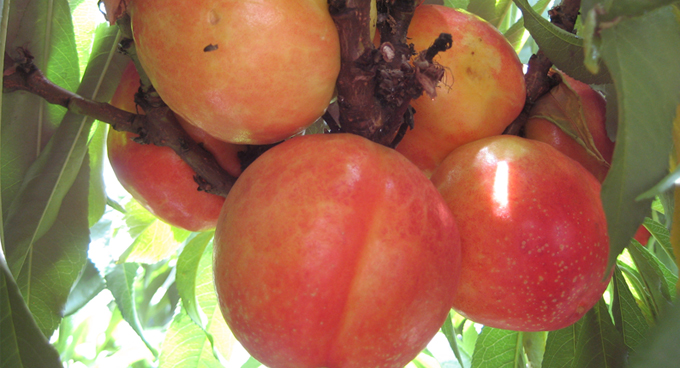
Of the fruit trees growing at BAAG, one that stands out as a great plant selection is the Nectazee standard at the front entrance (our north eastern parterre bed). Nectazee standards are part of the Fleming’s Trixzie miniature fruit tree range which is made up of Nectazee Nectarines, Pixzee Peaches, White and Black Cherree Cherries and Pixzee Pears. Like most other dwarf fruit trees, barring dwarf pomegranates which are ornamental anyway, these produce full sized fruit on miniature sized trees.
Regular Nectazee trees are 1.5m x 1.5m, whereas Nectazee standards, like the one we have planted here at BAAG, are grafted to 1m tall rootstock, increasing their height to 2.5m. Both edible and ornamental, these grafted standards or “lollypop” shaped trees can fill that 2-3 m height level in a garden bed (hard to do for a tree!), whilst allowing you enough room to grow small shrubs and ground covers underneath. Another endearing characteristic of these trees is their ability to hide their treasure, surprising you with their gleaming orbs when you peek underneath their long weeping leaves (pictured). I suppose the only drawback that we’ve found of ours is that it doesn’t seem resistant to brown rot, so remember to spray as you would for the fungal disease peach leaf curl and dispose of any mummified fruit if your tree does get affected and you should be right.
The best time to plant these trees is in during bare root season or in winter when the trees are dormant, so to get a Nectazee standard in your garden don’t forget to include one in your winter planting schedule.
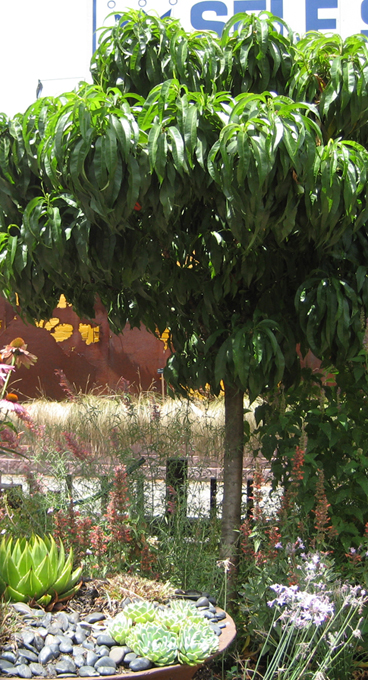 |
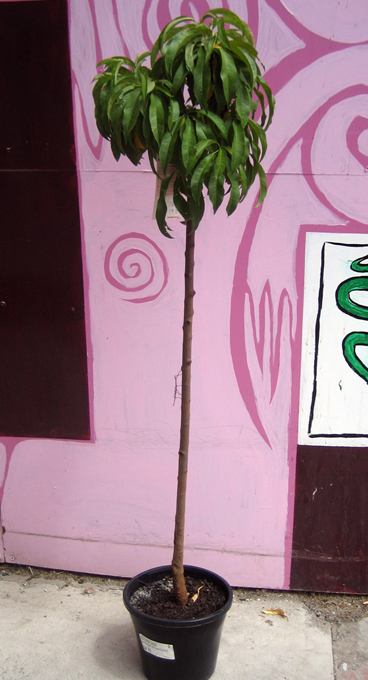 |
